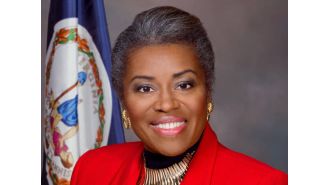Injured Nuclear Workers Finally Had Support. The Trump Administration Has Mothballed It.
An advisory board of scientists, doctors and worker advocates helped ensure that nuclear workers exposed to toxins received proper compensation. The terms of nearly all board members expired last month — and no new members have been appointed.

Nearly three years ago, President Barack Obama responded to long-standing concerns that workers exposed to toxic chemicals at the country’s nuclear weapons labs were not receiving proper compensation.
Obama created an advisory board to be composed of scientists, doctors and worker advocates. Their recommendations have led to significant changes, including the repeal of a rule that made it more difficult for workers who’d been injured in the last two decades to get compensation.
President Donald Trump and his administration have taken a different approach: His Labor Department has let nearly all of the board member’s terms expire — and so far hasn’t nominated new ones.
“For two years our board put a lot of brain power and cutting-edge expertise into developing recommendations,” said Ken Silver, an occupational health professor at East Tennessee State University, who until last month was a board member. “Without appointing another board, those recommendations may disappear into the ether.”
Silver was one of 14 members on the Advisory Board on Toxic Substances and Worker Health whose terms expired in February. The remaining member’s term expires in the middle of this month. The Department of Labor has kept silent on when it will appoint a new board. Meetings have been put on hold until further notice, according to the Labor Department’s website.
The department did not respond to multiple requests for comment. However, in a letter sent this week to Cold War Patriots, a workers’ advocacy group, an agency official said nominations are still being reviewed.
The now-defunct board is among a long list of vacancies that plague the Department of Labor, where four of 14 key politically appointed positions lack nominees, and five others haven’t been confirmed by the Senate, according to data collected by the Washington Post and the Partnership for Public Service. More broadly, the Trump administration has faced ongoing criticism for its inability to fill key government jobs — and keep high-level jobs staffed. The vacancies have in many cases depleted the ability of federal officials to do their jobs and made it more difficult for people to access public services, critics say.
Chris Lu, who served as deputy labor secretary under Obama, said his former agency is hamstrung with so many positions vacant.
“You have seen this happen throughout the federal government,” he said. “It reflects a larger level of disorganization, some might say dysfunction.”
“It is very troubling that this board is allowed to lapse,” he said, adding that the board was critical to making needed changes in the compensation program.
The advisory board’s main function is to serve as a check for the Department of Labor’s Energy Employees Occupational Illness Compensation Program, which has faced criticism for delaying sick workers’ claims for years and being deliberately complex and opaque. Though its recommendations aren’t binding, the Labor Department under Obama took action on some of them.
Since 2001, the illness compensation program has paid upwards of $14 billion in medical benefits and compensation to more than 118,000 Department of Energy employees who worked at the nation’s nuclear facilities such as Los Alamos National Laboratory, and have been diagnosed with radiation- and chemically-induced diseases. Thousands of additional claims are pending. (A separate board, which remains active, advises the federal government on radiation-related claims.)
But the way in which the Labor Department has administered the program has been criticized. In 2016, the Government Accountability Office found that in roughly 10 percent of toxic substance claims reviewed, officials had denied them without looking at the scope of the chemicals and risks present at the work site. Moreover, the GAO found, decisions over benefit awards contained inaccuracies — including the wrong medical conditions — and were not consistently reviewed by supervisors.
Another GAO report from 2010 found there was no independent oversight or expertise in how the department handled chemical-related claims. As a result, there was little way to show decisions were scientifically or medically sound, the report found. It also found limited transparency in how the department handled chemical claims.
Advocates say the now-defunct board was changing things and are concerned about what its absence might mean, particularly if it drags on.
Sen. Tom Udall, D-N.M., who supported legislation to establish the board in 2014, said he and workers’ advocates are concerned about the board’s lapse and said it could harm the scientific integrity of the Department of Labor program.
“DOL’s failure to reappoint the board by last month’s deadline is worrisome, and I urge the department to take quick action to ensure qualified individuals are in place as soon as possible,” he said in an email. “Any extended lapse of the board would be extremely concerning and potentially hazardous to the health and livelihoods of workers throughout New Mexico and the nation.”
New Mexico is home to two of 17 national laboratories — Los Alamos and Sandia National Laboratories — and receives the most Energy Department funding of any state.
Last December, Democratic Sens. Patty Murray and Maria Cantwell, both of Washington state, wrote to Labor Secretary Alexander Acosta, urging him to reappoint the 13 members of the board who asked to continue serving, saying the recommendations made by the board have “strong scientific and medical rationale and have been thoroughly debated.” (Two members did not want to be reappointed.)
“The [compensation] program is vital to many of our constituents who have and continue to work at Hanford in extremely hazardous conditions,” they wrote, referring to the Hanford nuclear site in their home state. They added that the board has only acted to improve the program’s handling of toxic exposure claims.
Many of the claims date back decades, when worker protections were minimal — or absent. It was commonplace for workers to perform dangerous tasks for months or years without protective clothing, masks or health monitoring, and without being told of the potential risks. Some board members and doctors say they are seeing more workers whose claims are tied to exposures in recent years.
Cold War Patriots and the Alliance of Nuclear Worker Advocacy Groups, another national organization that supports the rights of nuclear workers, sent similar letters to the Labor Department asking for current members to be quickly reappointed.
Workers advocates are also concerned about the Trump administration’s handling of other labor issues. In the last year, the administration has repealed executive orders put in place by Obama that required federal contractors to disclose labor law violations. The Labor Department also overturned recordkeeping enforcement for workplace injuries and illnesses and stalled regulations that would have better protected workers from silica exposure, which can cause lung cancer.
The vacant board may indicate larger issues with oversight for the Energy Employees Occupational Illness Compensation Program.
“It is a complicated program,” said Dr. Steven Markowitz, who was the board’s chairman and is a professor at Queens College at CUNY School of Public Health in New York. “It took us a while and I think we are still learning. If they were to appoint a new set to go through that learning curve again, that would be kind of a shame.”
While the board is only required to meet twice a year, in its first two years it held six full board meetings and 17 subcommittee meetings. Markowitz said delays in appointments will further set back future board meetings, which must be scheduled in the Federal Register at least six weeks out, and could create a loss of momentum.
During their last meeting, on January 30, board members compiled a nine-point list of pending items and suggestions for a new board to address, such as reassessing the standard by which workers’ chemical exposures are reviewed during the claims process and gathering data on the types of claims the Labor Department most frequently denies.
Silver, the former board member, said the board served as a check against “a sometimes insular bureaucracy, so without our board, policies and procedures for adjudicating these claims will regress to stale thinking.”
The board was created only after years of intense lobbying. In 2014, Congress passed the 2015 National Defense Authorization Act, calling for the board to be appointed by the president. In June 2015, Obama issued an executive order, transferring that authority to the labor secretary, effectively giving the department the power to decide who would hold it accountable.
Over the next nine months, lawmakers reached a compromise with the White House. Rather than have then-Labor Secretary Tom Perez select the board, a three-member team of senior federal officials reviewed and recommended the 15 final nominees. Perez appointed their choices. Finally, in April 2016, the toxic substances board convened for the first time.
It is not clear if Acosta, the current labor secretary, will follow the same process. Udall said he hopes the new board members will be as independent as the ones they will replace.
“Protecting our workforce and compensating workers exposed to harmful substances is of paramount importance,” Udall said. “Especially when the federal government itself is the employer.”






